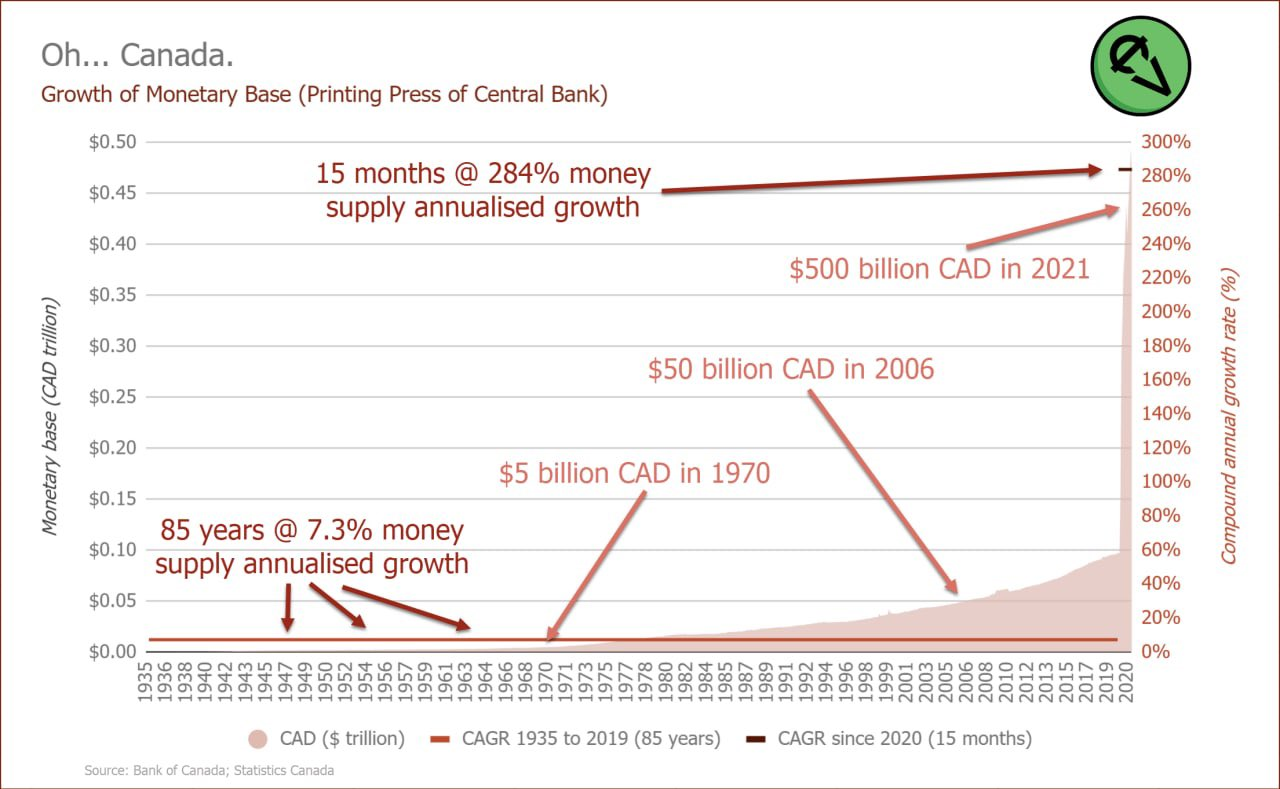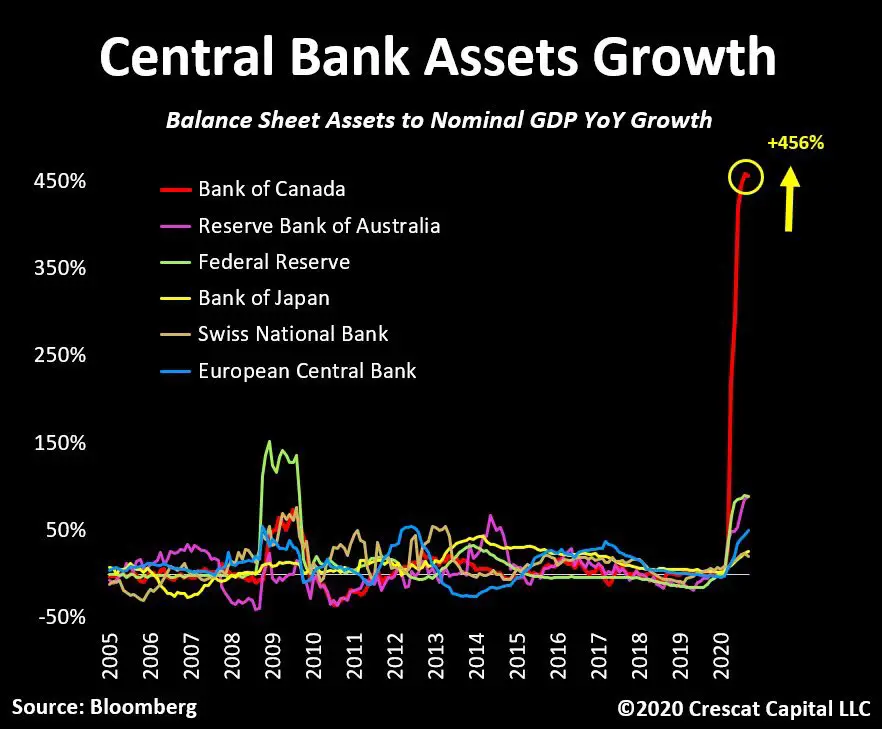But, that will require countering the propaganda of those who have an interest in inflating away our wealth.
Inflation continues to rise.
According to the government, inflation in Canada is now 4.7%, up from 4.4% in September.
That’s the highest rate of inflation since 2003, when the rate also hit 4.7%.
To get a sense of how high that rate is, BNN Bloomberg notes, “Inflation hasn’t exceeded that level in the three decades since the Bank of Canada first started targeting inflation in 1991.”
And that’s just the rate the government claims.
It is widely felt and believed that the real rate of inflation is much higher.
Regardless, it is clear that surging inflation isn’t a ‘transitory’ phenomenon as the Bank of Canada erroneously claimed.
Instead, surging inflation is the inevitable result of two main things:
Massive money printing, and virtue-signaling climate policies.
On the first point, many central banks, including the Bank of Canada, printed a massive amount of money over the past year-and-a-half.
To get a sense of how truly immense their intervention was, consider the charts below:


Amazingly, there are still some who claim that all this money printing has nothing to do with inflation.
But to claim that would be to completely ignore reality.
If you print a bunch of fiat currency and increase the money supply at a far more rapid pace than the supply of goods, then you have more money chasing fewer goods.
Thus, the value of each individual unit of money goes down, which then makes prices appear to be higher.
Now, at this point, those who defend all this money printing will claim that the real problem is supply shortages, and some recovery of demand following the strictest period of lockdowns.
However, those issues are absolutely connected to the massive printing of money.
Consider where this increased demand comes from.
In terms of printing money and then distributing it, the Canadian government/Bank of Canada were among the most interventionist in the world.
While lockdowns took place and more and more people stayed home, demand dropped, as would be expected. At the same time, the government distributed an immense amount of fiat currency, leading to – in many cases – people putting the money into their savings accounts.
Thus, there was a bunch of pent up demand, demonstrating that the government went far beyond the goal of helping those at risk of losing their jobs and instead drenched the nation in fiat currency.
As a result, once the lockdowns started to loosen for those who are vaccinated, there was more demand for goods.
However, there was a far larger increase in the supply of money than there was in the supply of goods, and people are losing purchasing power as a result.
Of course, it is true that there is shortage of many things, including energy.
But why is this?
Is it just a coincidence?
Is it just a result of the end of lockdowns?
Or, is it something more?
This is where the issue of climate virtue-signaling comes in.
The real cost of the climate crusade
What happens if we transition to ‘clean energy’ before it is economically feasible?
What happens when the leaders of the world’s wealthiest countries try to cripple their own economies?
And what happens when people vote for those who promise the most aggressive ‘climate action’ while assuming ‘someone else’ will pay for it?
Well, we are seeing exactly what happens: a shortage of cheap energy – particularly devastating since cheap energy is a core foundation of civilizational wealth creation – shortages of other goods, higher prices for key staples, and the ongoing decimation of the earning power of the populace.
What does all of that amount to?
A lower standard of living.
And this is exactly what those in power want, even if they won’t admit it.
Think about it for a second.
There are two ways for a civilization to use less energy.
The first is through rapid technological advancement, where a cleaner and more efficient energy source is both cheaper and more effective (this is what oil was compared to coal).
The second is through making the population poorer. Poorer people on average use far less energy, and the richer someone gets the more energy they use. Just consider how the carbon footprint of the average COP26 attendee compares to yours. Unless you are flying around the world on a private jet constantly, chances are they have a much higher carbon footprint than you do.
On the first point, rapid technological advancement is indeed happening all across our society. The Canadian energy sector, for example, has become much more environmentally friendly and much more efficient. Indeed, the innovation that takes place in nations that value individual freedom and free enterprise is much more impressive than in nations that try to centralize power.
But, politicians don’t like solutions they don’t directly control.
So, they are opting for the second option, making their populace poorer.
What we are seeing now is a result of the two things at the top of mind for politicians like Chrystia Freeland and Justin Trudeau: The desire to reduce the wealth of Canadians, while still getting re-elected.
Now, you may be thinking – “didn’t you say the government printed a bunch of money and gave it out to people? How can you be claiming they want to reduce our wealth?”
The answer is that having more fiat currency doesn’t mean having more wealth, if the value of that currency is rapidly eroding.
This is tough for many to grasp, because we spend our whole lives thinking about money in terms of ‘a higher number=more wealth.’
However, if you get a 2% raise, while the value of your money declines by 5%, you have lost 3% of your earning power. You are poorer than you were.
And this is what is happening to people across our country. They are being made poorer and poorer by a government that wants them to ‘consume less’ and is forcing that upon them by robbing them of their hard-earned purchasing power.
Further, the more money the government spends, the more private economic activity and opportunity is crowded out, which further eliminates economic opportunity while generating more dependence on the state.
A political realignment
All of this could lead to a political realignment in Canada.
For many years, climate virtue-signaling and the massive expansion of the government has felt ‘consequence free’ for most Canadians.
That made it easy for people to ‘feel good’ by supporting the politicians who virtue-signaled the most, and then assuming that their own lives would be unaffected.
But now that more and more people are seeing that climate virtue-signaling and massive increases in government spending/money printing is going to make themselves and their families poorer, many will be looking for an alternative.
The question is whether a real alternative will actually present itself in the House of Commons.
If the Conservative Party goes in the direction that Pierre Poilievre has been speaking about, limited government, sound money, an emphasis on free enterprise and the private sector rather than the centralized state, then the CPC would be a real alternative to the statist agenda of the Liberals & NDP.
The CPC will have trouble doing that so long as they remain stuck in the Liberal narrative on the issue of climate change and the role of government however, since their current carbon tax policy is a deeply statist proposal that would increase the cost of living by forcing people to give some of their money to the government, and then be ‘allowed’ to spend it on government approved ‘green items.’
It takes courage and strength to go up against the dominant narrative at this time, but with inflation surging and Canadians seeing the true impact of Justin Trudeau & Chrystia Freeland’s failed policies, now is the time for the principled advocacy of true conservative principles, rather than surrendering at the first sign of controversy.
Spencer Fernando
***
You can support Spencer Fernando’s writing by making a contribution through PayPal, or directly through Stripe below.
[simpay id=”28904″]
